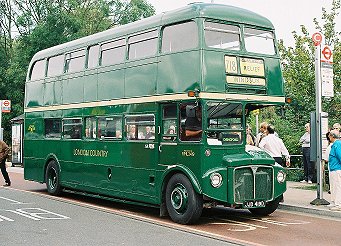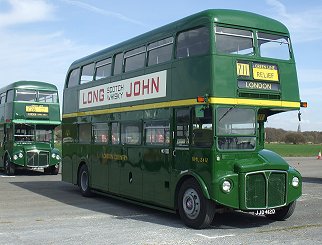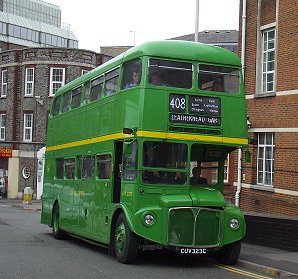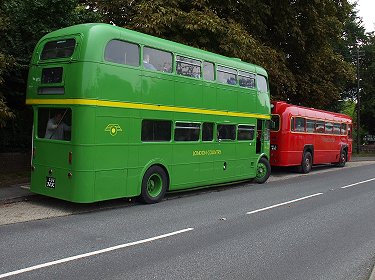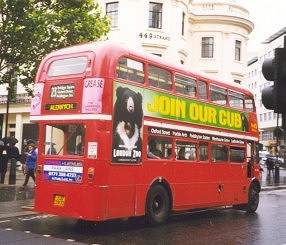
Prepared on Notepad by Ian Smith,
|
| Date | Route | Garage | Type displaced | Displaced by.. |
|---|---|---|---|---|
| 9/68 | 249/A: | WW | RML | MBS |
| 9/68 | 165: Havering Park - Romford - Rainham | RD | RM | RML |
In November 1968, the Ealing Area reorganisation resulted in a change of home for some of Hanwell's RMLs, as responsibility for the 207A shifted to nextdoor Southall (HW: the old Hanwell bus garage; HL was earlier the Hanwell trolleybus depot)
| Date | Route | Garage | Type displaced | Displaced by.. |
|---|---|---|---|---|
| 11/68 | 207A: Hayes Stn - Chelsea | HL-HW | RML (HL) | RML (HW) |
The Merlins affected the Country Area too,
and a Windsor area reorganisation in March 1969 saw most of the WR fleet transferred to Northfleet (NF),
where they displaced RTs on the 497, 498 and 487.
Harlow also suffered with Merlins in March, but its RMLs all stayed locally,
displacing RTs from other local routes..
London Transport also established a new "personal" home-to-factory service in Stevenage,
the Blue Arrow service, to start at Christmas 1969, just before the handover to London Country.
This required three of the Daimler Fleetlines from East Grinstead,
which were replaced by three XA class Atlanteans officially transferred from the Central fleet.
By way of recompense, the Country Area surrendered three RMLs
(2441, 2443 and 2321), which were repainted
| Date | Route | Garage | Type displaced | Displaced by.. |
|---|---|---|---|---|
| 3/69 | Windsor reshaping | WR | RML | MB |
| 3/69 | 497: Gravesend - Northfleet | WR | RML | MB |
| 3/69 | 498: Gravesend - Painters Ash | WR | RT | RML |
| 3/69 | 487: Swanscombe -Gravesend - Singleswell | WR | RT | RML |
| 3/69 | Harlow reshaping | HA | RML | MB |
| 12/69 | A1: Stevenage Blue Arrow | SV | new service | XF |
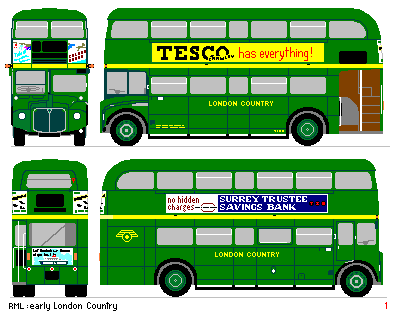
London Country
The remaining 97 green RMLs were all transferred from London Transport to London Country
when it came into being on 1st January 1970.
The RMLs, along with the sizeable fleet of RTs and Country RFs, had their cream bands changed for yellow,
had their fleetnames changed,
received "flying polo" logos and lost their radiator badges
(which featured an LT bullseye).
(First priority of all new managers: make sure they know whose it is;
whether it works comes second.)
For the first two years of London Country the RMLs stayed where they were,
doing what they were built for.
RMLs immediately received London Country fleetnames and flying polo emblems. At repaint some received a richer green and a canary yellow band. Preserved RML2412 is at Loughton in September 2009, RML2419 at the Cobham Bus Gathering in April 2010..
London Transport and the GLC
Less publicised than the London Country transfer, the Central Area and Underground of London Transport were transferred to the control of the Greater London Council in January 1970. There were no immediate outward effects on the buses. The fleetname lost its underline, but that had been decided previously by LT's design panel. More Merlins arrived, followed by shorter Swifts and the DMS class. Meanwhile, many of those new RMLs that had been given to Croydon in early 1968 were taken away in April 1970 and put into store. They were replaced by the XA Atlanteans, which had been modified for OMO flat-fare operation, now legal with double-deckers.Some of the stored RMLs were used for extended tests at the Road Research Laboratory at Crowthorne, until they all went back to work in mid-June, at Stamford Hill (SF) and Wood Green (WN) on the 243.
| Date | Route | Garage | Type displaced | Displaced by.. |
|---|---|---|---|---|
| 4/70 | 130 group- C group | TC | RML | XA (omo) |
| 6/70 | 243: Wood Green - Holborn Circus | WN, SF | RM | RML |
1971: the DMS arrives.
The new Daimler Fleetline class went into service first on RM routes, but in January 1971 took over Highgate's 271 route, which was no stranger to Fleetlines, having been host to the Country Area XFs during the comparison trials. The RMLs did not move far, going to Muswell Hill (MH) for route 43.In September Holloway (J) closed, its allocation, including RMLs, moving to Highgate (HT), which assumed the title Holloway (HT). Clear? Also in September Wood Green (WN) lost its RML allocation for route 243, after just 15 months, in a reorganisation where the route and buses passed to Tottenham (AR).
| Date | Route | Garage | Type displaced | Displaced by.. |
|---|---|---|---|---|
| 1/71 | 271: Highgate - Moorgate | HT | RML | DMS |
| 1/71 | 43: Friern Barnet - London Bridge Stn | MH | RM | RML |
| 9/71 | 14: Hornsey Rise - Putney / Kingston | J-HT | RML (J) | RML (HT) |
| 9/71 | 243: Wood Green - Holborn Circus | WN-AR | RML (WN) | RML (AR) |
1972: approaching overhaul time.
At the start of 1972 Peckham lost its share of route 37, the RMLs passing with the allocation to Stockwell.| Date | Route | Garage | Type displaced | Displaced by.. |
|---|---|---|---|---|
| 1/72 | 37: Peckham - Hounslow | PM-SW | RML (PM) | RML (SW) |
During this year the RML 7 year examinations would become due,
so from early in the year the green RMLs went through overhaul in a steady stream,
most under contract at Aldenham, some at Godstone and Garston.
All retained their original bodies. Those treated at Aldenham were repainted.
The first few were repainted in Lincoln Green,
then between April and October Aldenham turned them out in a mid-green
with yellow fleetnames. Some dealt with at garages never did get a repaint.
But by the end of the year they were appearing in corporate NBC green.
The new management of the NBC were applying the First Law of Management in their turn.
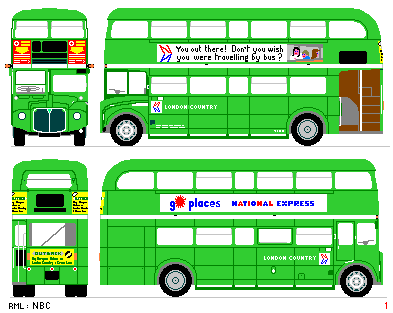 A more significant change occurred in February in the Country Area where the 410 route
from Bromley to Reigate, with frequent Bromley - Biggin Hill short workings,
was taken over by new AF class Fleetlines.
The displaced RMLs went to Windsor.
(One of them ventured later in the year to High Wycombe to take over a
schools contract from an overburdened RF until an MBS was available).
A more significant change occurred in February in the Country Area where the 410 route
from Bromley to Reigate, with frequent Bromley - Biggin Hill short workings,
was taken over by new AF class Fleetlines.
The displaced RMLs went to Windsor.
(One of them ventured later in the year to High Wycombe to take over a
schools contract from an overburdened RF until an MBS was available).
| Date | Route | Garage | Type displaced | Displaced by.. |
|---|---|---|---|---|
| 2/72 | 410: Bromley North - Biggin Hill - Reigate | GD | RML | AF |
| 2/72 | 407/A: Langley Village - Cippenham | WR | RT | RML |
| 2/72 | 441: Staines - High Wycombe | WR | RT | RML |
| 2/72 | 457/A: Uxbridge - Windsor | WR | RT | RML |
| 2/72 | 335: Watford - Windsor | WR | RT | RML |
| 2/72 | 353: Berkhamsted - Windsor | WR | RT | RML |
| 9/72-11/72 | 372: High Wycombe schools | HE | RF | RML |
Not many RMLs were treated to the medium green and yellow livery, but RML2323 was one. It has been restored to this unusual condition, and was on the 408 between Guildford and Epsom on the Leatherhead Running Day in September 2010.
An overhaul float was established at Aldenham for the Central Area's 7-year inspections/overhauls. The buses for the float came from West Ham and Leyton, where the 262 was reduced to RM operation, (using some RMs from the disbanded RM float). The RMLs started to cycle through their overhauls, many re-emerging with different bodies.
| Date | Route | Garage | Type displaced | Displaced by.. |
|---|---|---|---|---|
| 7/72 | 262: V&A Docks - Chingford Stn | WH, T | RML | RM |
The cantrail band changed from mist grey to white at the end of the year.
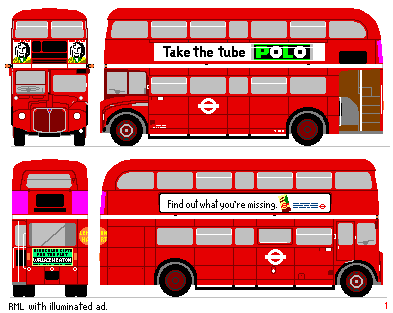
1973-4: Spares shortages begin to bite.
The only omo conversion affecting RMLs was at Hornchurch, where the 165 went over to DMS operation in June. The RMLs displaced were not re-allocated as a block, but were distributed to ease shortages elsewhere. The demise of AEC had not helped a world-wide shortage of spare parts that bedevilled transport undertakings everywhere from Muswell Hill to Nairobi during the seventies. Meanwhile London Transport was coming towards the end of its brief fling with standee single-deckers: the Merlins were to be sold, and the RMs retained.
From April 1974 the livery changed slightly,
in that the fleetname was replaced with a white roundel (or bullseye).
| Date | Route | Garage | Type displaced | Displaced by.. |
|---|---|---|---|---|
| 6/73 | 165: Havering Park - Romford - Rainham | RD | RML | DMS |
The spares shortage began to cripple the Country Routemasters too, and they began to be laid up awaiting the receipt of spares.
Some were robbed beyond recovery: RML2306 (EG), RML2319 (GD) and RML2426 (NF) would never work again
after 1973. Six more followed into terminal Christmas-tree status during 1974.
This situation sometimes meant that theoretical allocations or changes never actually occurred,
with the new "allocations" covered by borrowing.
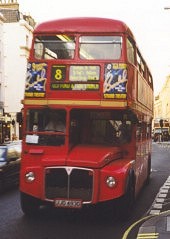
1975: More conversions.
Although the Merlins and Swifts were fast disappearing, and the DMS was proving less than ideal, these were still being delivered. In January 1975 the 43 at Muswell Hill lost its RMLs to crewed DMs, the RMLs going to Stonebridge for route 18, in turn releasing some of the RMs needed for the 47 conversion.In February the overhaul round finished and the RML float was disbanded. The released buses were allocated to Willesden for route 8 and to Shepherds Bush for the 88, and were joined by the last RMLs from Croydon's 130 group as they were replaced by DMs.
More RMLs went to route 8 at Bow (BW) when Chalk Farm's route 24 was changed over to DM in October 1975. Muswell Hill (MH) also received some of the RMLs, this time for route 13.
Route 8 still has RMLs in 1998. Stagecoach East London's RML2493 one evening in August 1998, near Victoria.
| Date | Route | Garage | Type displaced | Displaced by.. |
|---|---|---|---|---|
| 1/75 | 43: Friern Barnet - London Bridge Stn | MH | RML | DM |
| 1/75 | 18: Edgware Stn - London Bridge Stn | SE | RM | RML |
| 2/75 | 8: Old Ford - Willesden Garage | AC | RM | RML |
| 2/75 | 88: Acton Green - Mitcham | S | RM | RML |
| 10/75 | 24: Pimlico - Hampstead Heath | CF | RML | DM |
| 10/75 | 8: Old Ford - Willesden Garage | BW | RM | RML |
| 10/75 | 13: Golders Grn Stn - London Bridge Stn | MH | RM | RML |
In the Country Area the spares/availability situation became even more dire. By summer 1975 nearly half the RML fleet was unroadworthy, recertification for many being out of the question for lack of spares. Buses were being borrowed from anyone who had any spare, to keep the services running. There were Queen Mary PD3s from Southdown, other PD2s from Maidstone and PD3s from Southend, Fleetlines and Roadliners from Bournemouth, Bristol MWs from Royal Blue, AEC Regents from Eastbourne. RMLs were "released" from Hemel Hempstead's 334, 337 and 338, and were officially allocated to Tring and Garston, but nothing happened in practice except that on the routes mentioned the covering omo buses were now official. Hemel Hempstead's remaining actual running RMLs were distributed during 1976 to help paper the cracks.
1976: ..and more.
In February 1976 the Hanwell (HL) RMLs were ousted by crew-operated DMs for route 207. They went to Hendon (AE) for the 13 and 113. Others went to West Ham (again) for route 23.More RMLs from route 207 went in March when the Uxbridge allocation was converted. These went to Upton Park, to join the earlier transferees on route 23.
Today's route 23 has almost nothing in common with the 1976 route except the RMLs. RML2390 is seen heading away from Trafalgar Square in June 1998, working for CentreWest (First Bus) from Westbourne Park to Aldwych.
| Date | Route | Garage | Type displaced | Displaced by.. |
|---|---|---|---|---|
| 2-3/76 | 207: Uxbridge Stn - Shepherds Bush Green | HL, UX | RML | DM |
| 2/76 | 13: Golders Grn Stn - London Bridge Stn | AE | RM | RML |
| 2/76 | 113: Edgware Stn - Swiss Cottage Stn | AE | RM | RML |
| 2-3/76 | 23: Becontree Heath - Aldgate | WH, U | RM | RML |
In the Country the RMLs were gradually filtering back into service,
and with some of their duties permanently transferred to new Leyland Nationals
the vehicle availability position eased. Fewer buses from outside were needed,
and even the Godstone Queen Marys, bought from Southdown in July 1975, were retired in September.
High Wycombe garage closed in October, with its services being covered by omo buses from Amersham.
The remaining RMLs from HE moved to Garston for Watford services. Although many of these too had been
converted, the move did allow Garston to fill all its RML rosters with RMLs, for the first time for years.
But in October, 29 RMLs were put up for sale to London Transport, as non-runners
(along with 7 RMCs and 2 RCLs).
On inspection 17 of the RMLs were deemed to be incapable of resurrection,
and were sent direct to Wombwell's in Barnsley for component recovery.
A further deal was negotiated for thirty runners too,
and these included 16 RMLs (I think), which began to move to LT by the end of the year.
1977: Some Country RMLs sold to LT.
During 1977 London Country's new vehicles started to make a serious dent in their RML requirement.
Leyland National buses were taking over all around the edges,
and the trunk routes, such as the 409, were falling to new Atlanteans.
New work was found for a few good RMLs at garages that had not used them before,
such as Dorking, Stevenage and Hatfield.
1978: Busplan brings route re-allocations.
In January the first ex-Country RMLs, repainted red, went into service for London Transport, one (RML 2347) as a trainer, and another eight for bus duties. Others started a heavy overhaul at Aldenham, and started top appear for duty in March. One of the repaints also went back in for overhaul. By the end of 1978 25 RMLs had been put into service.The Bus Plan reorganisation of routes brought changes to RML allocations in October. Muswell Hill (and Hendon) lost their allocations on the 13, Finchley taking over the whole 13 allocation with RMLs. Tottenham lost their RML allocation from the 243, and Riverside's 74B was withdrawn. Hounslow (AV) got some more for the 37, and Bow (BW) received some for the 8A, displacing RMs.
| Date | Route | Garage | Type displaced | Displaced by.. |
|---|---|---|---|---|
| 10/78 | 243: Wood Green - Holborn Circus | AR-FY | RML(AR) | |
| 10/78 | 13: Golders Grn Stn - London Bridge Stn | MH-FY | RML(MH) | RML(FY) |
| 10/78 | 74B: Camden Town - Hammersmith Broadway | R | RML | withdrawn |
| 10/78 | N89: Southall - London Bridge Station | R | RML | RM |
| 10/78 | 37: Peckham - Hounslow | AV | RM | RML |
| 10/78 | 8A: Old Ford - London Bridge Stn | BW | RM | RML |
Significantly, London Transport acknowledged in a report to the GLC
that ticketing systems to provide fast opo were just not available,
and that therefore the RMs would be kept going as long as economically possible.
Also, as many as possible should be bought back from other concerns,
for use for spares or as runners.
More Country redundancies.
During 1978 Country RMLs were still allocated officially for duties at:
But the real allocations showed some differences from the official position:
The 347/A at Garston was converted to opo in September,
but enough new buses were not available.
This resulted in the RMLs from the 347/A being shunted to different routes
to release vehicles, such as the 348.
More new buses in October saw most of the Reigate and Godstone
RMLs demoted to use as trainers.
Two remained in passenger service at Godstone.
1979: Continuing change in the Central Area
Route 24 went back to RML operation in April 1979, Stonebridge swapping them for DMs from Chalk Farm in order to counter an increasing vandalism problem with the open-platform Routemasters on route 18. The first Fleetlines had already left LT for scrap whilst RMLs were being gathered in.| Date | Route | Garage | Type displaced | Displaced by.. |
|---|---|---|---|---|
| 4/79 | 24: Pimlico - Hampstead Heath | CF | DM | RML |
| 4/79 | 18: Edgware Stn - London Bridge Stn | SE | RML | DM |
The RMLs were not involved in the Shillibeer or Shoplinker exercises.
Two RMLs (2423 and 2424) were scrapped after London Country sold seventeen Routemasters to
Wombwell Diesels in March. They should have gone to London Transport,
but a disagreement between the companies had flared.
LT was supposed to supply spares for LC to repair the buses prior to completion of sale.
But LC had difficulties finding engineering capacity for the job,
while its new buses were mis-behaving,
and LT had difficulties in providing the necessary spares whilst its own
RML fleet was in need.
Each thought the other was dragging its heels. Deadlock. Bad temper.
LC sold some buses for scrap. LT was alarmed. New negotiations in a hurry.
A new agreement. LT would take the remaining RMLs (and others), store them,
and use them as and when it saw fit.
LT also arranged to buy back the other six RMLs that had been sold to Wombwell.
LT arranged for secure storage in the Royal Albert Docks,
and began to take them.
A few RMLs were still in service with London Country,
and RML 2446 was restored for passenger work from training
because of continuing bus shortages.
Another, RML 2445, became Swanley's first RML in December,
and RML 2452, also from Northfleet, went to Chelsham.1979: Towards expiry in the Country Area
The Country RMLs gravitated towards Northfleet during 1979, including the "unofficial" allocations.
The North Kent environment had never been kind to LT green paintwork
(in Country STL days it had been seriously mooted that a change should be made to harder-wearing red),
due to the cement dust in the atmosphere.
During 1979 the outward condition of the Northfleet buses deteriorated markedly.
Meanwhile, in September, London Transport pressed four of the ex-LC RMLs into trainer service
without even benefit of a coat of red paint.
(This was unusual for the RMLs although commonplace for RMCs and RCLs).
1980: Finale in the Country Area
The remaining Country RMLs were withdrawn in February when the 403 (CM)
and 407/A (WR) were finally converted, and passed to London Transport.
A chapter had closed, and even the optimistic did not foresee another twenty years service ahead for the stored hulks.
London Transport now put considerable effort into restoring the ex-Country buses.
Even the Christmas Tree, RML2345 from Grays, eventually had all its robbed parts replaced.
The availability of the Country RMLs for service allowed more Central routes to be converted back from Fleetline to RML operation: Cricklewood (W) swapped DMs for RMLs on the 16/16A in May. Hanwell received a mixture of RMLs and RMs between August and October 1980, and gradually adjusted the mix in favour of RMLs as they became available in the following two years. (Uxbridge received RMs for its share)
| Date | Route | Garage | Type displaced | Displaced by.. |
|---|---|---|---|---|
| 5/80 | 16/A: Victoria Stn - Sudbury Town | W | DM | RML |
| 8-10/80 | 207: Uxbridge Stn - Shepherds Bush Green | HL | DM | RM, RML |
| 8/80 | 207: Uxbridge Stn - Shepherds Bush Green | UX | DM | RM |
The decade ended as few had predicted at its start. The Merlins and Swifts had not lived up to expectations, and only a few remained on Red Arrow work, soon to be ousted by Leyland Nationals. The DM crewed Fleetlines had proved too slow for busy city-centre routes, and were on their way out. New Metrobuses and Titans were coming into service, but did not affect the RML routes. The future for the RMLs seemed secure, as no-one could see a different solution that would work on the busiest London streets.
Part Three: The eighties
 Part One: Into service
Part One: Into service
 Part Three: The eighties
Part Three: The eighties
 photos
photos
 histories
histories
 Ian's Bus Stop
Ian's Bus Stop
 RM Contents
RM Contents
 RCLs
RCLs
 RMLs
RMLs
 RMFs
RMFs
